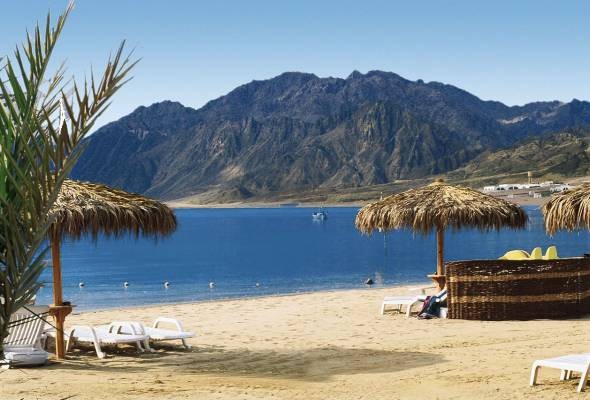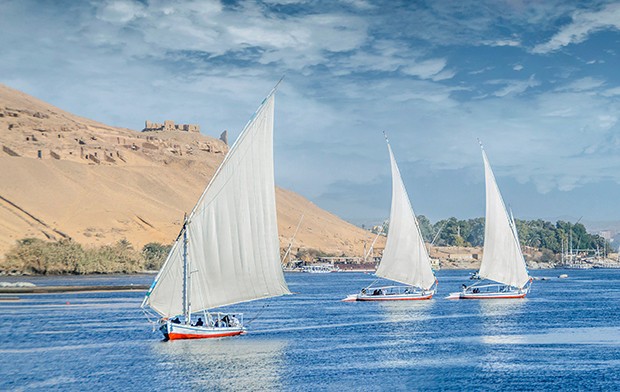
Honeymooners – Cairo – Nile Cruise – Aswan – Luxor – Hurghada – Cairo
Honeymooners – Cairo – Nile Cruise – Aswan – Luxor – Hurghada – Cairo
Highlights of the Program: Cairo City: It’s the capital of Egypt & one of the largest cities in Africa & Middle East which built more than 1000 years old ago. It’s very rich of historical sites (Pharaonic, Coptic & Islam...
Read more...INCLUDED
Program includes
- Meet & assist before the immigration at the airport.
- 03 ways Cairo Airport Transfer by Private A/C vehicle
- 01 ways Airport transfer in Aswan with private A/C Vehicle
- 02 ways traveling by private air-conditioned vehicle (Luxor / Hurghada – Hurghada / Cairo).
- 03 Nights' accommodation in Cairo based on Bed & breakfast
- 03 Nights' accommodation at 5* Nile Cruise based on Full board excluding beverages.
- 03 Nights’ Accommodations at your Choice of Hotel in Hurghada on Soft All Inclusive basis.
- All entry fees for sites mention in the program.
- Day tour in Cairo to visit The Old Egyptian Museum and The Great Giza Pyramids.
- Cruise Sightseeing as mentioned in the program (Maybe will be joint tours).
- Water Activity in Hurghada.
- Private Egyptologist guide during the tour.
- Available language: English, Spanish, German & French (other language with supplement).
Add Value:
- Complimentary Wedding cake & Fruit Basket.
- Upgrade to higher category according the availability.
- Unlimited mineral water & snacks during the sightseeing.
- Local Sim-Card with internet date per family per package.
- Complimentary Camel Ride for 10 minutes during Pyramids visit.
EXCLUDED
Package Excludes
- Egypt Entry Visa
- International flight ticket as well as the domestic flight ticket if any.
- Any optional tours or Meals or Beverage during tour or Personal expenses or any services didn’t mentioned in the itinerary.
- Travel insurance
- Tipping.
NOTES
Important notes & traveling tips:
- The major schedule of the cruises:
- 03 nights ex Aswan on Wednesday or Friday & few cruises on Monday.
- 04 nights ex Luxor on Saturday or Monday & few cruises on Thursday.
- Rate based on the above mentioned number of travelers, in case there is an increase or decrease in the number of travelers or change of date, Egypt Promotion Travel keeps the right to change its rate accordingly.
- All transfers throughout the entire trip on a private basis by A/C Deluxe Vehicle.
- All above mentioned sightseeing on Private basis on Cairo and joining other guests on board the cruise, including entrance fees
- Cruise itineraries may be changed without prior notice due to navigational circumstances may be in sequences but not in visits.
- Rates are including taxes and service charges
- Hotels official Check in at 15:00 hrs. & Check out at 12:00 hrs.
- Cruise official Check in before lunch at 12:00 hrs. & check out after breakfast at 08:00 hrs.
- International meals are served at the hotels and onboard the cruises.
- Full Day tours start at 09:00 hrs. Till 17:00 hrs. (Maximum 8 hours).
- Half Day tours start at 09:00 hrs. Till 13:00 hrs. OR at 12:00 hrs. Till 16:00 hrs. (Maximum 4 hours).
- Our rates do not include any kind of insurance.
- Our Rates are including all applicable taxes.
- Drones and wireless planes are not allowed in Egypt at all and will be confiscated at borders on arrival.
- Tipping is a way of life in Egypt which is used even among Egyptian citizens to show their satisfaction & appreciation toward the provided services & all kinds of tips are not included in our rates unless stated in our inclusions.
- There are 2 accepted ways of payment in Egypt:
- Credit card (fees 2.5% of total amount).
- Bank transfer (excluding banking fees according to your bank regulations).
- Room Types & special requests:
- Triple Rooms are usually twin or double rooms with rollaway extra beds & not 3 standard beds.
- Twin rooms or King Size bed rooms are subject to availability on check in date as cannot be confirmed in advance.
- In case accommodation special request: we can confirm only when we get a hotel confirmation otherwise it will be according to their availability upon check-in time.
- Please make sure that your passport is valid for at least 6 months prior to the arrival date to Egypt as some airlines set a condition of this minimum validity in order to avoid any problems while checking in to the flight.
- Weather in Egypt – The climate of Egypt is a hot season from May to September and a cool season from October to April.
- Dress Code in Egypt – we recommend a proper dress code according to the traveling month. The hot shorts are not recommended especially at religious places & allowed in resort cities like Sharm, Dahab, El Gouna, Marsa Alam and Hurghada.
- Some nationalities can apply for visa directly using link https://www.visa2egypt.gov.eg/eVisa/Home?VISTK=R0UQ-4Y5W-9YE7-J4ES-IHM2-ZQ84-V2SU-TUYU-ADQC-C5D6-TH8W-MVJR-NU0S-RJRY-PTLX-63LH
-
1Day 01: Arrival to CairoUpon arrival at Cairo Airport you will be met by Egypt Promotion representative who will assist you through airport customs & formalities.You will be escorted immediately to your hotel in one of our air-conditioned modern vehicles.Arrive to hotel; check in overnight in Cairo.Meals: No Meals
-
2Day 02: Full Day Pyramids, Sphinx & Egyptian Museum.Breakfast at the hotel.Meet your guide at Reception and start a day tour by visiting The Great three Pyramids of Giza & the Sphinx.Continue to visit The "Egyptian Museum".After this long interesting tour day; transfer back to the hotel.Free time in Evening & overnight at Hotel.** Optional: attend the sound and light show at Pyramids Area.Meals: Breakfast.
-
3Day 03: Cairo – Aswan – Cruise – Aswan Sightseeing.Check-out after breakfast at the hotel.Transfer to Cairo airport to travel to Aswan by domestic flight.Meet & assist upon arrival by Egypt Promotion Travel representative at Aswan airport & transfer to the Nile Cruise.Arrive to the cruise and leave the luggage & meet your guide who will escort you to visit the High Dam & the amazing Philae temple.Return to the cruise, check-in & have lunch.Evening is free at leisure to do some optional excursions which will be offered by your guide according the availability or simply enjoy your stay on the cruise.Dinner and overnight onboard of the cruise.Meals: Breakfast, Lunch & Dinner.
-
4Day 04: Aswan – Kom Ombo – EdfuBreakfast onboard of the cruise.Sail to Kom Ombo & visit the temple.Back to the cruise and lunch onboard of the cruise.Said to Edfu.Arrive to Edfu & visit the temple.Sail to Luxor.Dinner & overnight onboard of the cruise.Meals: Breakfast, Lunch & Dinner.
-
5Day 05: Luxor – SightseeingBreakfast onboard of the cruise.Transfer to enjoy visiting the major sightseeing in Luxor which includes West Bank (The Valley of the Kings, Hatshepsut Temple, the Colossi of Memnon).Back to the cruise and lunch onboard of the cruise.Evening is free at leisure to do some optional excursions if time permitted or simply enjoy your stay on the cruise and be ready to travel back to Cairo the next day.Dinner & overnight onboard of the cruise.Meals: Breakfast, Lunch & Dinner.*** Please Note: the cruise itinerary might be changed without prior notice according the navigation circumstances.
-
6Day 06: Luxor – Hurghada:In the morning: disembarkation after breakfast onboard the cruise ship.Transfer to visit East Bank (Luxor & Karnak temples).Egypt Promotion Travel representative will pick you up from the hotel and escort you to travel to Hurghada by private air-conditioned vehicle.Arrive to Hurghada and transfer to the hotel to check-in.Afternoon is free at leisure.Overnight at the hotel.Meals: Breakfast, Lunch & Dinner.
-
7Day 07: Water Activity in HurghadaBreakfast at the hotel.Egypt Promotion Travel representative will arrange you a wonderful tour to enjoy Water Activities and Sports.He will pick you up from your hotel in Hurghada and escort you to do:* Banana Boat Ride.* Glass Boat tour.* Parasailing adventure.After finishing this nice tour; your will be transferred back to the hotel.Meals: Breakfast, Lunch & Dinner.
-
8Day 08: Free at leisure in HurghadaBreakfast at the hotel.This day is free at leisure to enjoy sun and sandy beach.Overnight at the hotel.Meals: Breakfast, Lunch & Dinner.
-
9Day 09: Hurghada – CairoBreakfast at the hotel and check-out.Egypt Promotion Travel representative will pick you up from the hotel and escort you to travel to Cairo by private air-conditioned vehicle.Arrive to Cairo and transfer to the hotel to check-in.Afternoon is free at leisure.Overnight at the hotel.Meals: Breakfast.
-
10Day 10: Final DepartureBreakfast at the hotel & check-out.Our Egypt Promotion Travel representative; transfer to Cairo International airport for final departure to back home with sweet memories & friends you made in Egypt.Meals: Breakfast.
Choose Hotel
PRICING PLANS
- # NO. OF ADULTS NO. OF CHILDREN TOTAL
- Room 1 x $0 x $0 $0
Related Tours
Egypt promotion provides you with very rare Egypt tour package deals for 2024. Make your vacation package special by choosing one of our tailored packages in Egypt.










